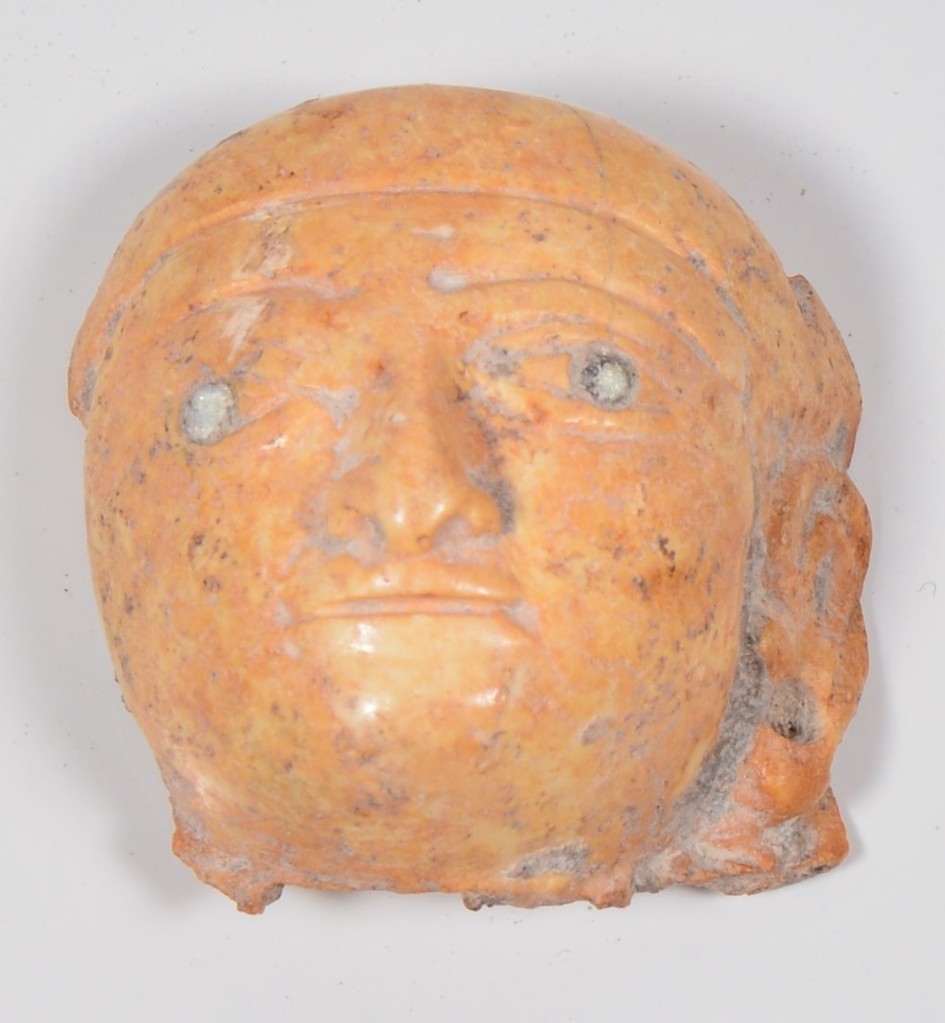By Ben Watts-Wooldridge
In this past semester at UVic, GRS 482A gave me the unique opportunity to study archaeological material from the site of ancient Eleon. For my research, I studied a carved head made of bone, found in the destruction layer of a structure in the southwest quadrant of the site (Figure 1). The bone head appears to be an import, with facial features consistent with Late Bronze Age sculpture of the eastern Mediterranean. It therefore raises several questions, not only about its use at Eleon, but also about Eleon’s participation in eastern Mediterranean exchange networks. Where did it come from? Who was using it, and what were they using it for? This blog post will summarize my research and focus particularly on the purpose and origin of the bone head, using clues from the excavation context and Near Eastern comparanda.

The bone head was found among the floor deposit of a partially-excavated structure. The purpose of the building is unclear, but objects found within it serve as helpful clues. The bone head was recovered from a deposit that also included a full range of domestic pottery, a copper fibula, and fragments of bovine figurines. These bovine figurines are well attested throughout the Mycenaean Aegean in sanctuaries and funeral contexts: the presence of these fragments, along with the domestic pottery assemblage, may indicate that the head was used for domestic cult activity.
The bone head’s flat backside shows that it was likely fixed to another object. Plaque/composite figurines, a style of figurine with a flat backside that is meant to lay flat or be attached to another surface, are found throughout the eastern Mediterranean and are often associated with ritual contexts. If the bone head was indeed meant to lay flat or be inlaid in another surface, its use as an object of ritual significance would make sense. The findspot does not feature an altar, or any other typical identifiers of a ritual space, but perhaps further excavation will shed more light on this question of the structure’s ritual importance.
In order to find out where the Eleon head came from, and how it might relate to wider systems of exchange between the Aegean and the Eastern Mediterranean, I searched through various excavation reports for sites in both Anatolia and the Levant. The most appropriate comparanda come from cities and settlements located on the Levantine coast.
The site of Megiddo, located in modern day Israel and well-known for the large hoards of Late Bronze Age worked ivories found in its Late Bronze Age levels, holds several interesting parallels to the bone head from Eleon. An ivory cosmetic container, carved from an Elephant tusk and featuring a figurine head at one end, is especially compelling (Figure 2). Not only are the facial features similar, but the head also features inlaid glass beads used for the eyes. Other objects from Megiddo similarly share this feature of inlaid glass, a theme which I was hard pressed to find elsewhere. Although there is no reason to believe that the Eleon head was used as a cosmetic container, this shared characteristic of glass eyes on worked bone/ivory makes the Levant a strong candidate for a region of provenance.
The site of Ugarit, located on the Syrian coast, furnishes additional parallels. Bone and ivory carvings are found throughout the site, including some examples similar to the Eleon head (Figure 3). It is notable that Ugarit has also produced a vast array of Mycenaean ceramics and figurines. With well-documented trade in Aegean ceramic wares (and perhaps their contents) flowing into the region throughout this period, it’s not hard to imagine how our bone head may have found its way to Greece as part of a return cargo.

In the future, further analysis could be helpful in determining a more precise provenance. Analyzing the isotopic data of the bone collagen would provide us with information regarding the ecological environment of the animal from which the bone was taken. The same isotopic analysis could also be done on the glass eyes. When compared with the isotopic data of glass assemblages from around the Mediterranean, we may be able to narrow in on specific centers of glass production, perhaps in Mesopotamia or Egypt. A greater understanding of the bone’s background, as well as the production of the glass, would be a helpful next step in further understanding the bone head’s story.
The mystery of the Eleon bone head remains just that: a mystery. While its provenance is still somewhat unclear, it does appear to have origins outside of the Aegean – at the very least, this can tell us about the role that trade and imports played in the lives of individuals living at Eleon. Some of the evidence points towards its use as an object of ritual significance, but more excavation and analysis will be needed to prove it. This mysterious nature of the bone head made my research challenging, but the opportunity to study such a unique object in the world of Aegean archaeology made it worthwhile. I gained new experience working with materials from an active excavation, and it taught me how inspiring and rewarding placing an artefact within its historical context can be. I am leaving the bone head with more questions than answers, but I hope that further analysis and excavation can provide us with more clues as to the production of the bone head and its use at Eleon. Hopefully I can have a part in the next steps of this research, and perhaps I will even get to meet the bone head in person one day!